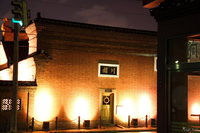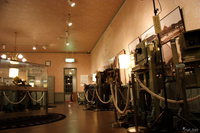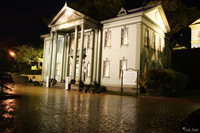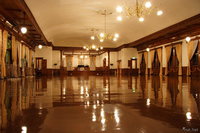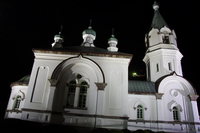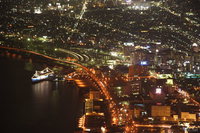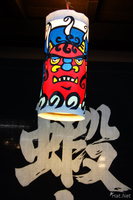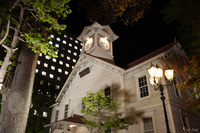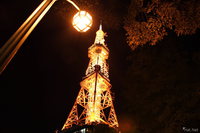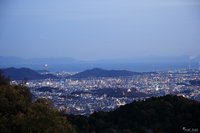sleepless nights
*Note: This is the picture of the memorial hall, not the graveyard. I took some pictures of the Chinese graveyard, but the picture didn't turn out (that was because of the rain not because of the ghosts). I was thankful for the rain because it forced me to come to the temple district earlier than I planned.
That gave me enough time to visit the museums before they closed. I have copied a large paragraph of text from the graveyard, so I can only paste them here. The graveyard is about 30 minutes north west from the Chinese memorial hall (inside the cemetery for foreigners).
The Chinese Graveyard: There have been Chinese people living in Hakodate Since the end of the Edo period, most of them being engaged in trade of marine products.
The graveyard dates from 1876 when six Chinese rented the land from the local development office in order to lay the remains of those Chinese who drifted in from Aomori Prefecture. It was only 607 square meters In area at the beginning. Through the purchase of neighboring land In 1919. the graveyard was extended to 1,538 square meters and also enclosed by a brick wall, giving it its present appearance.
In the graveyard, there are several monuments including a tiled roof shrine made of Japanese cypress and a stone monument for those who tied no one to grieve for them (called Chinese Glcho)
The graveyard has been managed by Chinese residents of the area for generations Every year in April and August. they hold a ceremony. In which they burn paper money, to pray for the souls of their ancestors.
Text by City of Hakodate
The Hokkaido Prefectural Government's Old Branch Office In Hakodate was built In 1909 and was restored in 1982 together with the construction of an adjacent park.
One of its main features is a portico; the two-story roof is supported by four huge Column capitals (Corinthian order) and pillars which bulge Slightly in the middle (Entasis-style).
This Western-style structure is highly valued. as it shows the Hakodate of the late Meiji period as well as history of Hokkaido Colonization. Because of its historical significance, the Hokkaido Government designated it as a tangible asset In 1985.
Today. Its first floor serves as a Motomachi tourist information office. and the second floor Is open to the public as a Hakodate City museum of photograph history." where valuable photography equipment and documents are displayed to show Hakodate's history as an early hub of photography in Hokkaido.
This dates from 1859 when It was built as a temple attached to the first Russian Consulate. It was formerly called "Hakodate Sanctuary of the Resurrection."
In 1869 the young priest Nicholel came to Hakodate from Russia to propagate the Russian Orthodox Church for the first time in Japan after the embargo on early Christianity in Japan was removed. (He was transferred to Tokyo in 1872.)
In 1907 it suffered a disastrous fire and was rebuilt in 1916 in the Russian Byzantine style of architecture. The domed celling inside this temple was of characteristic design. The crown-like structure with many crosses on the roofs and decorations is unique. The green copper roof was repaired in 1968 and the blue-green hue was created chemically.
The two ton bell was moved to Nicholei Hall in Tokyo which had been damaged by Kanto Earthquake in 1923. It was exchanged for 6 bells, large and small. People loved this church and called it "Gangandera" meaning the melody of ringing bells. These bells were handed over to the government use during the war.
The present bell was given by a master caster from kuwana city in Mie prefecture in June 1983.
This church was designated as an important cultural asset in June 1983.
Text by the city of hakodate
From this picture, you can see the port, the Hakodate JR train station and Toyoko Inn (the hotel I stayed).
CEMETERY FOR FOREIGNERS is on the north eastern side of Hakodate (not on this picture). I paste the text here merely because I have lost the photos I took in the graveyard.
The cemetery area, which used to be called Yamasedomari, was the original cemetery for sailors who died during their port call at Hakodate, and for foreign residents of Hakodate.
Gravestones for late sailors of Perry's fleet and the first British fleet were placed there back in 1854 and 1855 respectively. In addition, according to some records, French sailors who died of illness were buried there after the ship had to be rushed into port at Hakodate despite no diplomatic relations with Japan at the time.
By the year 1870, Britain and Russia already had their own cemeteries there. Following a new demand for Catholic cemeteries Hokkaido settlers decided to lend France a part of the area as a Catholic cemetery. It is currently a cemetery for the Congregation of the Sisters of St. Paul de Chartres.
In 1876 the cemetery for Chinese people, now called the Chinese Graveyard, became part of the larger Foreign Cemetery.
Text by City of Hakodate
The "Tokeidai" (Clock tower) was originally built as a drill hall for the Sapporo Agricultural College, which was established in 1876 as the first agricultural institute in Japan.
The building was erected in 1878 in the style of wooden architecture used in frontier lands of the United States in those days.
The large clock, manufactured in the U.S.A., has kept telling time since it was installed in 1881.
The Clock Tower, which houses the Exhibit Hall, is now an important national cultural property owned by the City of Sapporo.

